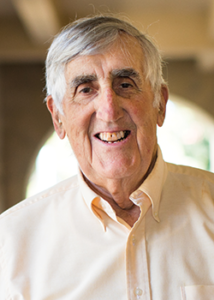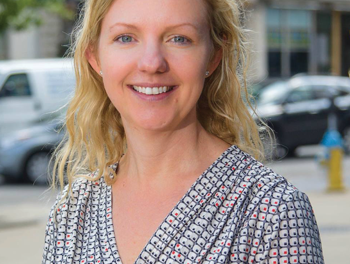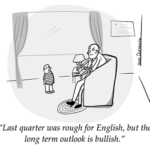PHI DELTA KAPPAN: On the first page of your newest book, Chasing Success and Confronting Failure in American Public Schools, you write that for more than 50 years, you’ve been “hooked” on the question of what counts as success and failure in public education. In other words, what do people consider to be a good school or program or teaching practice? What got you thinking about this question, and why have you kept coming back to it throughout your career as an educator and historian?
Larry Cuban: In the 1960s, I ran a school-based program in Washington, D.C., for returning Peace Corps volunteers who wanted to become teachers in urban schools. Two-thirds of the participants did, in fact, go into teaching and, more important, many of them stayed in the profession, even though teaching conditions in big city schools weren’t very appealing at the time. After a few years, the D.C. school system decided to incorporate the program into its regular budget, and President Lyndon Johnson’s administration created a National Teacher Corps, using our work at D.C.’s Cardozo High School as a model. From my perspective, then, the program seemed to be a great success. We got most of our participants to become urban teachers, the city’s schools liked the program enough to pay for it, and the federal government liked it enough to replicate it across the country. And yet, in 1970, the new superintendent of the D.C. schools got rid of the program. Clearly, he didn’t think it was worth it.
So I began to wonder, was the program a success or not? Well, that depends on the criteria we use to define success. If you ask whether it was implemented and did what it was supposed to do and got good reviews, then yes, it was successful. If you ask whether it improved the teaching force or led to greater student achievement, then we don’t know. And if you define a successful program as one that catches on and grows roots, then no, it wasn’t successful at all. It disappeared after a handful of years. Likewise, the National Teacher Corps lasted only until 1980, when President Reagan shifted most education funding into block grants for the states.
That’s when I began to understand how complicated it is to determine what has or hasn’t been successful in public education. You have to ask: Successful at what, for whom, and according to what criteria?
Kappan: What’s an example of a reform that did catch on and become part of the landscape — something that could be described as a huge success, at least in terms of its longevity?
Cuban: The best example is the organizational practice of grouping students by age. Through most of the 19th century, one-room schoolhouses were the norm in the U.S., but during the Common School era, when enrollments in public education began to increase, the age-graded school became standard. There was nothing inevitable about organizing students into age-based cohorts and having them move together in lockstep, from class to class, through 12 or 13 grade levels. But over time, that came to seem natural. To most Americans today, that’s what a “real” school looks like. Of course, the age-graded school isn’t necessarily the best way to organize for teaching and learning, but in terms of how widely it has been adopted and accepted, it has been as successful — if longevity is the criterion — as any school practice I can think of.
Kappan: Other than looking at how widely a model has been adopted or how long it has been around, what have been the main criteria we’ve used, in the U.S., to decide what counts as a good school?
Cuban: For much of the 20th century, the main thing was efficiency. It’s important to keep in mind that tax-supported public schools always reflect what’s happening in the larger society. Well, in the early 1900s, scientific management techniques swept through the corporate sector, where the idea was to make sure that every single part of an organization was operating as efficiently as possible. And this approach to management was widely adopted by school leaders, too, from the 1920s and ’30s all the way through the 1950s and into the ’60s. The belief was that the education dollar should be spent much more efficiently, without waste or corruption.
In practice, this meant that scientific management techniques were applied to absolutely everything that went on in schools. For instance, education professors created scorecards that administrators could use to keep track of whether school buildings were getting the recommended amount of sunlight and fresh air, whether the heat was set at the right temperature, whether the hallways were clear, and whether the toilets were clean. Scorecards for building efficiency were all the rage. There were also scorecards that principals used during classroom observations, to determine whether teachers were being efficient in the way they used their time and resources, including how they asked questions of students, assigned homework, administered and scored tests, and so on. The goal was to make sure that schools were preparing children for adulthood and the industrial workforce in the smoothest and most efficient way possible. For decades, that was the main criterion for determining whether schools were successful.
Kappan: How do John Dewey and other progressive educators fit into this story? In the first half of the 20th century, didn’t they provide a compelling alternative to what counts as a good school?
Cuban: Sure. Over that same period, Dewey and other pedagogical progressives (to distinguish them from the administrative progressives, who focused on efficiency) promoted the idea that children learn by doing and that a good school is one that educates the whole human being. They often pushed back against scientific management, arguing that the curriculum should be more relevant to the world outside the schoolhouse door and that schooling should be more humane. So yes, Dewey and others introduced a competing definition of a good education.
Clearly, though, the efficiency movement won out. A few pockets of Deweyan progressivism popped up around the country for a few years and then disappeared, mostly in cities and suburban areas where groups of upper-middle-class parents wanted their local school to provide a more humane and student-centered education. But those sorts of schools were very rare. In every kind of school, including affluent suburban schools, the focus on efficiency was dominant.
Kappan: When and why did the mania for efficiency come to an end?
Cuban: It didn’t come to an end so much as it was subsumed by a larger focus on schools’ “effectiveness.” I date the shift to the passage of the Elementary and Secondary School Act of 1965, which has been responsible for most of our federal spending on K-12 education over the last several decades and includes our largest federal program, Title I, which provides aid to schools in impoverished areas.
During the process of writing the law, Sen. Robert Kennedy inserted a provision specifying that test scores must be used as one measure of Title I’s success. Well, that may sound like a minor detail, but it had huge consequences. Suddenly, everything changed about the way we defined success and failure in public education. For a very long time, we had judged schools by how efficiently they spent taxpayer dollars on buildings, science labs, instructional materials, teacher salaries, and so on. But now we were committed to measuring the outcomes of all those investments. Were those investments effective? From this point on, the main way to identify a good school was to look at its record of student achievement, usually as measured by standardized tests.
Kappan: What do you mean when you say that the focus on efficiency was “subsumed by” the focus on effectiveness? How are the concepts related?
Cuban: The concern for efficiency didn’t go away after 1965. Keep in mind that public schools are tax supported, mostly at the local level, and local taxpayers will always want to know that their money is being spent wisely. The public has good reason to keep track of how much a new building will cost, how high teachers’ salaries will go, the cost of materials, and so on. So, efficiency is still part of what goes into our judgments about the overall effectiveness of our schools. It’s just no longer the most important thing. Since 1965, what counts as a good school has had much more to do with student test scores than with school administrators’ management of the budget, the physical plant, or the master schedule.
Kappan: But the meaning of effectiveness has evolved quite a lot over that period, hasn’t it? How did we get from using test scores as one measure of Title I’s success, to the incredibly complicated formulas used to determine school and teacher effectiveness under No Child Left Behind and Race to the Top?
Cuban: In the late 1970s and early ’80s, the corporate sector went through a lot of restructuring because of deep concerns about falling behind global competitors like Germany and Japan. And this concern bled over into debates about education, most notably in the 1983 Nation at Risk report, which gave us this notion that the public schools are, somehow, responsible for the health of the economy. In turn, that led to the argument that we needed stronger curriculum standards, tighter graduation requirements, more frequent testing, stronger accountability, and on and on, which required more and more data and number crunching. And U.S. public schools have been living with that version of business-driven “effectiveness” ever since.
Kappan: School reformers always seem to assume there has to be “one best” way to design and organize public education. For instance, early-20th-century school system leaders didn’t argue that some good schools are highly efficient — as they saw it, managerial efficiency was the only sign of a good school. NCLB didn’t judge schools’ effectiveness based partly on test scores and graduation rates; these were viewed as the only valid indicators of school quality. Why have we been so reluctant to allow for multiple versions of effectiveness or multiple ways of judging a school to be good?
Cuban: In 1974, when David Tyack coined the phrase “the one best system” in a book by that name, he wanted to capture the almost utopian way that early- and mid-20th-century school reformers thought about their work. In their minds, schools were either efficient and good or inefficient and bad; there wasn’t any other option. However, what Tyack didn’t know at the time was that this assumption that there had to be “one best” way of doing school, would continue long past the 1970s. It was one of the reasons that he and I eventually wrote our book Tinkering toward Utopia (1995). Continually searching for a “one best system” has become part of the DNA of American education, so it keeps turning up again and again, like it did in the design of NCLB, which imposed a single outcome as a standard of “goodness” for every school.
But, although we’ve always had a single dominant model of schooling, which policy elites have treated as the one best approach, educators also have a fair amount of wiggle room because American public education is both much larger and much more decentralized than in most other countries. We have 13,000 school districts, more than 100,000 schools, 50 million kids, 4 million or so teachers. Given the scale, we’re always going to see a lot of variation.
Plus, we’ve always asked our public schools to juggle multiple goals: They’re supposed to produce literate, civically engaged graduates who are prepared for the workplace. That’s a brief sentence, but it points to many different ways in which we can judge schools to be successful. We might consider one school to be good because it sends 99% of its students to college, another because its graduates go on to take leadership roles in the community, another because all of its students complete apprenticeships with companies and city agencies, and so on. And each of those goals can be adapted and reinterpreted. There are schools, for instance, that have defined the civic purpose of K-12 education to mean that their graduates should “change the world,” fixing the flaws in our society.
Kappan: But again, those alternative models represent a very small percentage of our schools. And if there were many more of them, wouldn’t that very quickly become too much variation? Imagine a large school district in which every other school operates under its own idea of what it means to be successful — one aspires to prepare active citizens, another to build moral character, another to train artists, another to help every student learn at their own pace and follow their own interests, and so on. Wouldn’t that district be unmanageable? Practically speaking, how can we keep track of student progress, compare data, hold teachers accountable, and govern a system in which half the schools are doing their own thing?
Cuban: I would turn the question around and ask, how can schools pursue their own definition of success within a system that requires some amount of conformity? And it turns out that a lot of schools are able to strike a balance. For instance, in my book, I go into some detail about MetWest, a public high school in Oakland, California. It’s part of the Big Picture network of schools, which started in Providence, Rhode Island.
MetWest’s curriculum and instructional model set it apart from other schools in Oakland. It’s committed to having every student, starting in the 9th grade, spend significant amounts of time at workplace internships — by, for example, working as a teacher’s aide or at a hospital or a computer graphics company. The school still teaches the academic subjects three days a week, and it still looks like a regular high school in most ways. But two days a week it focuses on internships, and teachers are closely involved in supervising students and helping them connect their academic subjects to their work experiences. That’s different from the norm. It tinkers with what David Tyack and I called the typical “grammar of schooling,“ referring to all of those incredibly familiar features of schools that most of us experienced growing up: The kids are there five days a week, they go from class to class, they sit in rows of desks, they’re organized into grades with other kids the same age, and so on. Again, to most Americans, this is what a “real” school looks like. But MetWest tinkers with these things, and the school has made a point of recruiting teachers who are comfortable with this model and who enjoy juggling the schedule this way and connecting students’ workplace experiences to the curriculum.
Kappan: So how does MetWest pursue its own definition of success while still complying with the district’s regulations and its accountability model?
Cuban: Remember, this is in the Oakland school district, which is committed to public school choice. MetWest is a charter school, and students have to apply to go there, which means it attracts parents and kids who want that kind of experience. And many do. The school has become popular enough that it has two campuses and a waiting list. That said, the school does look more or less like a traditional high school three days a week, and it has to live with the state’s requirements for testing, data collection, reporting of results, and so on. So, it does comply with the standard approach to measuring performance and defining success. It just doesn’t see that version of success as its driving goal. As far as the school is concerned, the most important indicator of its success has to do with helping students to take a real step into the adult world of work and develop a sense of responsibility, self-direction, problem-solving skills, and so on.
Kappan: We’ve had schools of choice like MetWest for a long time now, many of them predating the charter school movement. Over that time, have parents and system administrators become more comfortable having multiple kinds of schools in the same district, each with its own mission and definition of success?
Cuban: I think so. After all, that’s the American ethos, the notion that variety is good and that choice is extremely important. It makes sense to people that we can have multiple ways of defining a good school. Again, though, these remain a small percentage of our public schools. Most schools remain traditional, and test scores remain the dominant marker of success and failure.
Plus, while a school like MetWest may seem very different from most high schools, let’s not lose sight of the important ways it remains entirely familiar. By and large, what we call new or alternative models of schooling have only tinkered with the usual grammar of schooling — they haven’t strayed very far from the basic outlines of what most people think of as a real school. For instance, there are now somewhere around 7,000 charter schools in the U.S., and to my knowledge, every single one of them is age graded.
Kappan: In that case, what did you make of the XQ Super Schools project, the grant competition that the Emerson Collective sponsored in 2015, in the hope that grantees would come up with radically different, break-the-mold high schools?
Cuban: My first thought was “here we go again.” The comprehensive high school, the kind of school most of us attended, emerged in the 1920s, and ever since then we’ve seen repeated efforts to reimagine it, especially in the 1960s, ’70s, and ’80s. A few of those new models could be described as genuinely different — in the ’60s, for instance, there were some proposals to create non-graded high schools, and one actually opened in Florida. But we’ve yet to see anybody create a model that’s both truly different and has staying power, and there isn’t really any reason to expect that to happen as the result of the XQ project. If you want a new kind of school to succeed in the sense that it gets adopted in more than a couple of places and lasts more than a few years, then you have to temper your expectations.
Kappan: So, when it comes to creating new kinds of schools, we shouldn’t let the perfect be the enemy of the good?
Cuban: I think that’s true. When people dream up a new approach to schooling, it’s easy for them to imagine that it will be not just good but perfect. But once you actually try to open and sustain a school, it becomes obvious just how enormously complex and political the work is, and it becomes clear that you have no choice but to make political compromises to keep parents, students, teachers, and other constituencies satisfied. If you want a school to persist over time, succeeding in terms of longevity, then you can’t afford to seek perfection. The real goal is to create schools that are good enough. Good-enoughism is woefully underrated.

Larry Cuban is professor emeritus of education at Stanford University. Before becoming a professor, he taught high school social studies for 14 years in big city schools, directed a teacher education program that prepared returning Peace Corps volunteers to teach in inner-city schools, and served for seven years as a district superintendent. Trained as a historian, Cuban received a B.A from the University of Pittsburgh and an M.A from Cleveland’s Case-Western Reserve University. On completing his Ph.D. work at Stanford University, in 1974, he assumed the superintendency of the Arlington, Virginia, Public Schools, a position he held until returning to Stanford in 1981. During his time there, students at the School of Education selected Cuban for an excellence in teaching award seven times.
Since retiring, Cuban’s professional work has included teaching seminars at Stanford and other universities and devoting time to research and writing. His major research interests focus on the history of curriculum and instruction, educational leadership, school reform, and the uses of technology in classrooms. His most recent books is Chasing Success and Confronting Failure in American Schools (Harvard Education Press, 2020). He also blogs at http://larrycuban.wordpress.com.
ABOUT THE AUTHOR

Rafael Heller
Rafael Heller is the former editor-in-chief of Kappan magazine.









